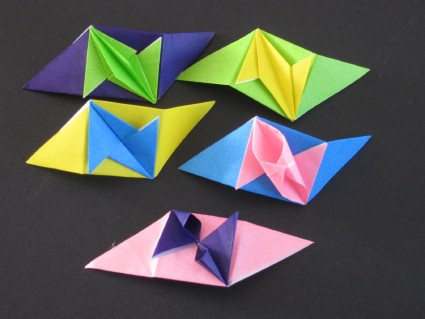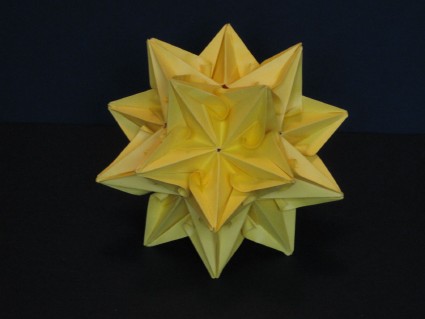
 | Welcome on MOOC-invitation |
|
| New! | An invitation to practice origami | map | Discovery of the world of folding paper Some major topics of folding paper |
| Back MOOC1 | Journey 2 | Sequence 3 | <--- page 10 | page 11 | page 12---> |
 |
Kusudamas |
| Decorative balls, or kusudamas, are a very active area of paper folding creation. They rely on the folding of a greater or lesser number of modules, for example 6 for a cube u to 90 for a dodecahedron. All modules have pockets and flaps, which allow to intricate the modules together to form the final ball. The departure of this branch of origami is generally associated with the discovery, in 1968, of the so-called Mitsunobu Sonobe module, which is not known to have been invented by him alone, or by Toshie Takahama alone (great Japanese folder) or by the two who worked together. The first model, very modest, is known as Toshie's Jewel, named after the folder (watch a video of the assembly of this jewel at Origami Modular Toshie 's Jewel by Origami Instructions). The potential of this module was discovered in the 1970s by other folders who showed that one could build a large number of regular polyhedra, well known to mathematicians (especially the Eulerian solids). Once the assembly of various polyhedra well mastered, an avalanche of more or less sophisticated modules fell on the world of paper folding. Even today, no week goes by without a new module being released. To build a modular decorative ball is done in five times, of very unequal durations: - choose the desired mathematical model: cube, hexahedron, octahedron, icosahedron, dodecahedron or any other variety of truncated or open polyhedra, - deduce the number N of modules to fold (6, 12, 30, 60, 90, ...), - prepare the N sheets intended to become modules (squares, rectangles A or 1: 2 or 1: 3 or ...) - fold the N modules (the number of folds for each of 5 or 6 to thirty ...), - assemble the N modules according to the scheme specific to the chosen polyhedron. The folding phase is particularly boring, especially if each module is made using a large number of folds, and may discourage some. One way to cut a little time folding is to gradually rise the ball, for example every 5 or 10 modules folded. But the real problem is the choice of paper and color (s). Mounting diagrams of 3, 4 6 colours polyhedra exist, having interesting visual properties. And if creating a decorative ball takes time, the result is always beautiful and makes a very appreciated gift! I recommend you to visit the sites of the high priestesses of the kusudamas: - Ekaterina Lukasheva kusudama.me , by clicking on the scrolling images at the top of the page. - Natalia Romanenko creations gallery or tutorials - Meenakshi Mukerji origamee.net beautiful collection of kusudamas ... and not only! - Maria Sinayskaia Go origami for her creations of kusudamas. But his site has many other wonders! Krystyna Burczyk ttps://www.flickr.com/photos/kburczyk burczyk% /, Curly modules specialist. Warning the eyes! |
14 photo(s)
 Original Sonobe module
Original Sonobe module |  Toshie's Jewel
Toshie's Jewel |  Toshie's jewel, another view
Toshie's jewel, another view |
 Some modules by Meenakshi Mukerji
Some modules by Meenakshi Mukerji |  Some modules by Ekaterina Lukasheva
Some modules by Ekaterina Lukasheva |  Some modules by Tomoko Fuse
Some modules by Tomoko Fuse |
 Some modules by Natalia Romanenko
Some modules by Natalia Romanenko |  Mary Diamond (5 sided bipyramid)
Natalia Romanenko
Mary Diamond (5 sided bipyramid)
Natalia Romanenko
|  Mary Diamond (octaahedron)
Natalia Romanenko
Mary Diamond (octaahedron)
Natalia Romanenko
|
 Mary Diamond (icosaedron)
Natalia Romanenko
Mary Diamond (icosaedron)
Natalia Romanenko
|  Mary Diamond (dodecahedron)
Natalia Romanenko
Mary Diamond (dodecahedron)
Natalia Romanenko
|  Kusudama « Estrela do mar »
Flaviane Koti
Kusudama « Estrela do mar »
Flaviane Koti
|
 Kusudama « Estrela do mar »
Flaviane Koti
Kusudama « Estrela do mar »
Flaviane Koti
|  Kusudama « Estrela do mar »
Flaviane Koti
Kusudama « Estrela do mar »
Flaviane Koti
|